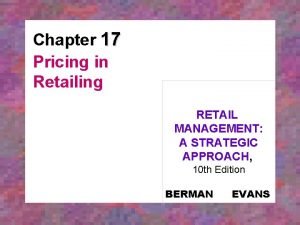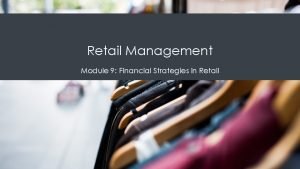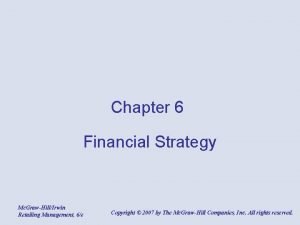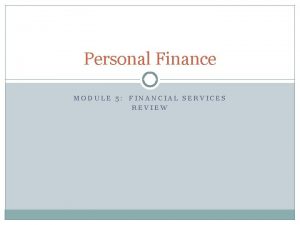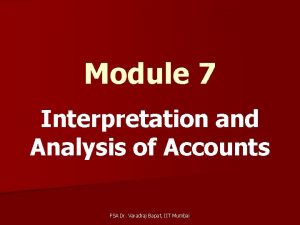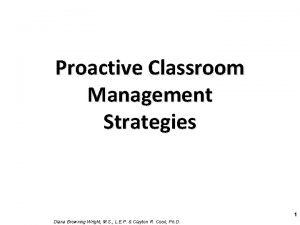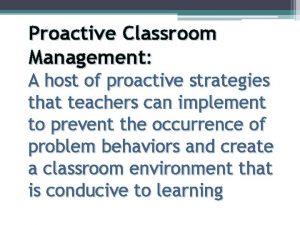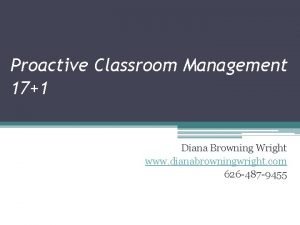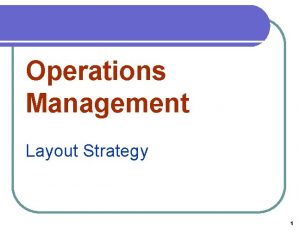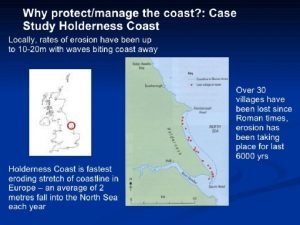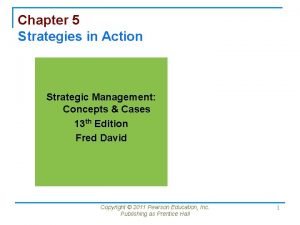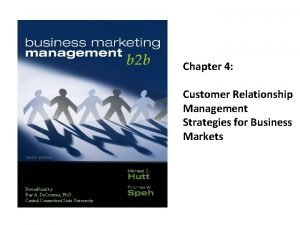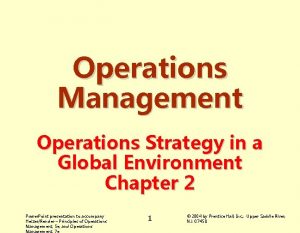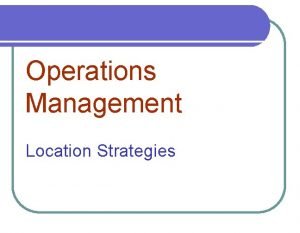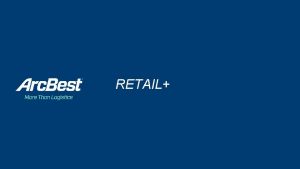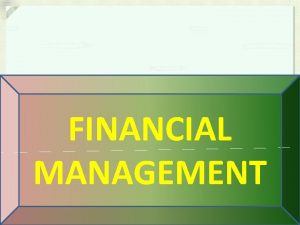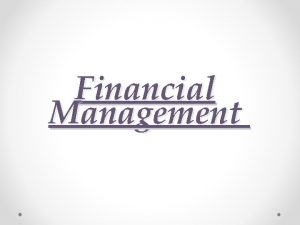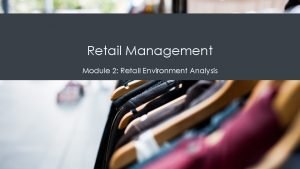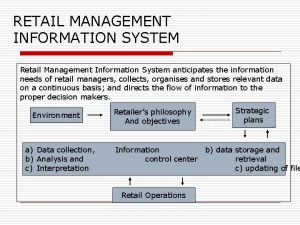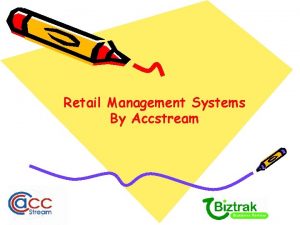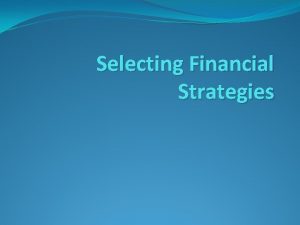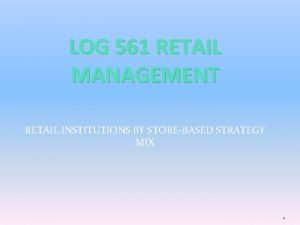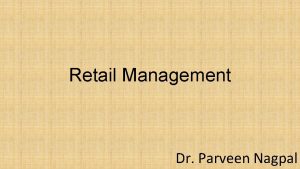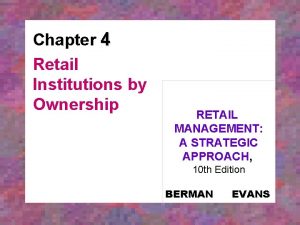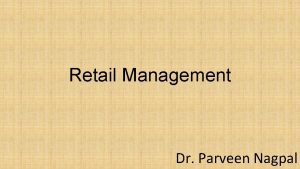Retail Management Module 9 Financial Strategies in Retail


























- Slides: 26

Retail Management Module 9: Financial Strategies in Retail

Financial Plans

Learning Outcomes: Financial Plans 9. 1 Use strategic profit modeling to create a financial plan • 9. 1. 1 Identify the financial goals of the business • 9. 1. 2 Analyze a profit-and-loss statement • 9. 1. 3 Compare various performance objectives and measurements

Financial Goals The goal of business is to make money to cover all expenses and grow the business. Use of ratios and calculations that can serve as helpful management tools for a firm: • • • Operating profit margin Asset turn-over Return on assets

Profit-and-Loss Statements • Income statement is accounting tool that reports a company’s financial performance over specific period • Businesses incur other operating expenses, related to selling + distribution, general + administrative, and financial • Income statement provides important information about financial performance of firm

Performance Objectives and Measurements • Performance metric measures organization’s behavior, activities, and performance • are finance based, but may also focus on performance against customer requirements • used to assess health of project and consist of safety, time, cost, resources, scope, quality, etc. Criticism: When the value of information is computed, it shows that even performance metrics professionals choose measures may have little value.

Income Statements

Learning Outcomes: Income Statements 9. 2 Explain how an income statement is used to evaluate a profit management path • 9. 2. 1 Define net sales, costs of goods sold, operating expenses • 9. 2. 2 Analyze the gross margin percentage of sample retailers • 9. 2. 3 Calculate the net profit margin of a sample retailer

Sales, Costs, and Expenses Note the four components of sales: net sales, cost of goods sold, gross margin, operating profit margin Why returns, discounts, allowances occur: • Retailer keeps damaged merchandise • Retailer buys in bulk quantities • Retailer picks up shipment at warehouse

Sales, Costs, and Expenses (cont. ) • Gross margin = net sales – cost of goods sold • Expressed in dollars or percentage • Operating profit margin = gross margin – (operating expenses + extraordinary operating expenses) • Concepts help examine financial performance, providing insight of business’ revenues and expenses

Gross Margin Percentage • Net sales – cost of goods sold • As a percentage, gross margin is divided by net sales (gross margin dollars / net sales) • 1 – gross margin percent = portion of sales spent as COGS • 1 – (COGS / net sales) = gross margin percent

Net Profit Margin • Net profit margin = operating profit margin – (extraordinary non-recurring expenses + interest payments + taxes + depreciation) • Interest (business loans), taxes (paid to government), depreciation (how much value has been lost) • Resulting net profit will be smaller than what is calculated for gross margin • Without deductions • Net profit margin comes after all considerations of expenses

Practice Question What does the word “gross” mean in gross profit margin?

Balance Sheets

Learning Outcomes: Balance Sheets 9. 3 Explain how a balance sheet is used to evaluate an asset management path • 9. 3. 1 Define asset, liability, and net worth • 9. 3. 2 Analyze the asset turnover rate • 9. 3. 3 Calculate a return on assets (ROA) for a sample retailer • 9. 3. 4 Use key ratios to inform decisions

Activity: Assets and Liabilities With a partner, write out the answer to these questions. • • • How do we define cash? What are fixed assets? What are liabilities? Long-term liabilities? What is the net worth is value of company? Now that you have a list of responses, discuss what it’s important to have a working knowledge of these concepts in retail management.

Asset Turnover Rate • Ratio of how many times during selling season, assets are turned over, or used • Asset Turnover Rate • ATR = revenue / net assets

Return on Assets • Refers to how much income is produced by its use of assets • Assets are inventory available for sale and dollars generated by sales • ROA = net profit / total assets or by multiplying operating profit margin x asset turnover

Key Ratios • Inventory turnover • • Current ratio Measure of financial strength (current assets / current liabilities) • Quick ratio • Return of investment

Budgeting and Cash Flow

Learning Outcomes: Budgeting and Cash Flow 9. 4 Explain the purpose and logistics of budgeting and cash flow • 9. 4. 1 Describe each decision of budget preparation • 9. 4. 2 Differentiate between zero-based and incremental budgeting • 9. 4. 3 List what needs to be documented in the ongoing budgeting process • 9. 4. 4 Explain the effect of seasonality on cash flow of some retailers

Budget Preparation • Many questions are asked about budget preparation, from expected sales, how much merchandise will be needed, what will price reductions be, & what is the gross margin • Challenge for business is to build budget that provides for financial health of company • If sales fall below budget projections, then there isn’t enough positive cash flow to cover all costs • Firm risks several outcomes (reinvestment, having competitors move ahead

Zero-Based vs. Incremental Budgeting Zero-Based: assumes budget is built from nothing • • Past activity should NOT be assumed Benefit: forces decision-makers to scrutinize assumptions about what is effective Incremental: using previous budgets and actual performances as baseline • • • Each item is adjusted to reflect activity, economic factors, consumer trends, etc. Make adjustments to year over year budgets Challenges decision-makers to analyze in depth

Ongoing Budgeting Process • Engage in ongoing budget process, meaning they monitor sales, cost of goods, and expenditures • Use information about performance relative to budget may be used to make macro-level adjustments • Make changes across categories, divisions, etc. • Budgeting is ongoing, it is not over when budget is finalized

Seasonality and Cash Flow • Seasonality refers to imbalance in timing of sales revenue • Examples: Winter holiday or Halloween merchandise, Think about heavy merchandising periods • • • January: Super Bowl February: Valentine’s Day May: Mother’s Day July: 4 th of July November: Thanksgiving

Quick Review Why is it important to offer right goods at right time, place, & price? What are the four components that make up profit management? Why do we compare performance and make for profitability? Why is financial analysis and planning a foundation of retail management?
 Pricing in retailing
Pricing in retailing Pricing strategies in retail management
Pricing strategies in retail management Retail strategic planning and operations management
Retail strategic planning and operations management Retail communication objectives
Retail communication objectives Human resource management in retailing
Human resource management in retailing Retail financial mgt
Retail financial mgt Retail financial strategy
Retail financial strategy Gap model in retail management
Gap model in retail management C device module module 1
C device module module 1 Retail financial strategy
Retail financial strategy Pete sets aside $50 each month
Pete sets aside $50 each month Vertical analysis interpretation
Vertical analysis interpretation Non financial methods
Non financial methods Diana browning
Diana browning Proactive vs reactive classroom management
Proactive vs reactive classroom management 17 proactive classroom management strategies
17 proactive classroom management strategies Interdepartmental flow graph
Interdepartmental flow graph Visitor management techniques in tourism
Visitor management techniques in tourism Holderness coast management strategies
Holderness coast management strategies Strategic management chapter 7
Strategic management chapter 7 Management issues central to strategy implementation
Management issues central to strategy implementation Implementing strategies: management and operations issues
Implementing strategies: management and operations issues Implementing strategies: management and operations issues
Implementing strategies: management and operations issues Strategies in action
Strategies in action Customer management techniques
Customer management techniques Operations strategy in global environment
Operations strategy in global environment Location strategy in operations management
Location strategy in operations management
